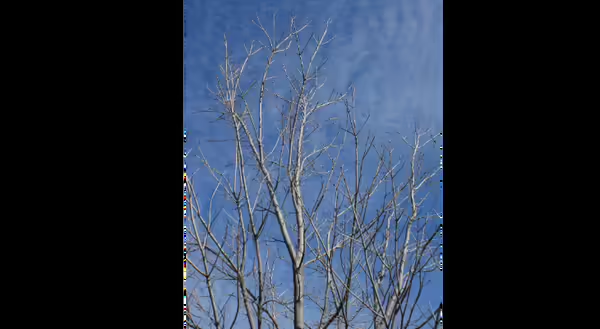
Wintertime offers few activities out in the garden, other than filling bird feeders and carefully watching dormant plants for any sign of awakening as spring nears. However, winter dormancy is the ideal time to prune woody plants. With trees and shrubs inactive in their winter slumber, pruning now can avoid interruption of the many plant process at play throughout the growing season.
Pruning is one of the most beneficial cultural practices we can apply in the landscape to help trees and shrubs maintain a healthy canopy and develop good branch structure. The list of pruning benefits is long including everything from improved resistance to disease and insects as well as other health boosting benefits, to simple improvements in aesthetics by creating a more balanced plant or a better view of other landscape plants or hardscaping.
Despite the long list, the importance of pruning shade trees cannot be overstated when you consider its influence on canopy structure. Proper pruning can have a lasting effect over trees, setting them up for a lifetime of healthy limbs while curtailing “fixable” problems before these issues threaten limb failure.
Many of us often don’t consider pruning shade trees until they are the large, mature specimens that tower over driveways, roofs and other major aspects of the landscape. However, properly applied pruning when a tree is young can correct many structural weaknesses that may wind up “unfixable” once a tree matures.
As an example, the majority of urban trees we see in parks, along boulevards and around homes have a cluster of branches that radiate out from the trunk in all directions at a very similar height, often about 6-8 feet off the ground. This becomes a structural issue as the tree matures with many large limbs attached to the trunk in close proximity which become a major portion of the overall canopy.
All of these closely attached branches are at risk of failure in the day to day stresses from wind as well as the many thunderstorms our area experiences each year. They simply don’t have as strong of an attachment to the trunk as limbs that are more evenly spaced out up and down the trunk and together they create a weaker section of tree trunk. This often can lead to one or more limbs peeling off the trunk but can also contribute to trunk failure in more extreme storm events. All of this structural weakness could have easily been fixed in the tree’s early years with some simple corrective pruning to properly space the permanent limbs up and down the trunk.
To give another example, there is often very easily accomplished pruning in a young tree that can create a more dominant central leader, or the tallest limb in the tree that represents the most active growing point at the tip-top. Establishment of a dominant central leader early on in a tree’s life by removing competing limbs can help the plant focus its growth upward as opposed to outward. Essentially, you will get a taller shade tree much faster that can provide valuable shade that much sooner.
Beyond focusing and optimizing growth, a well-established central leader, free from competition with adjacent limbs, also creates a stronger and more resilient canopy structure over all. It prevents future damage in the upper canopy from storms and other stresses by setting up better branch spacing and preventing the formation of weaker branch attachments at the trunk.
I often get questions as to why a tree needs help growing. Don’t trees out in a forest grow just fine without pruning? Haven’t trees done this for millions of years? The answer lies in the fact that urban trees typically don’t grow under pressure from adjacent plants, as trees do in the forest. With light being a major limiting factor, trees in a forest stand are forced to grow upward quickly or they get shaded out from completion. The resulting canopy structure typically creates well-spaced branches with a strong central leader. Whereas urban trees that are “open grown” and free of competition develop differently, often needing corrective pruning.
If you are interested in learning more about young tree pruning and all other aspects of tree care, the International Society of Arboriculture (ISA) has wonderful website packed with information. Visit the “Tree Owner Information” tab on their website for more information about pruning or use the “Find an Arborist” tab to identify ISA certified arborists in our area that can address all your tree pruning needs. The ISA website is accessible at www.treesaregood.org.